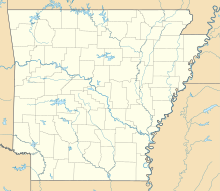Battle of Little Rock
| Battle of Bayou Fourche Engagement at Bayou Fourche |
|||||||
|---|---|---|---|---|---|---|---|
| Part of the American Civil War | |||||||
|
|||||||
| Belligerents | |||||||
|
|
|
||||||
| Commanders and leaders | |||||||
|
|
|||||||
| Units involved | |||||||
| Cavalry Division, Department of the Missouri | Marmaduke and Walker's cavalry divisions | ||||||
| Strength | |||||||
| 6,000 cavalry, 18 guns |
2,500 cavalry, 8 guns |
||||||
| Casualties and losses | |||||||
| 7 dead, 65 wounded or missing |
Probably about the same as Union casualties | ||||||
|
|
|||||||
The Battle of Bayou Fourche, also known as the Engagement at Bayou Fourche, was a battle of the American Civil War, and the principle engagement of the Little Rock Campaign. The battle was fought on September 10, 1863, in Pulaski County, Arkansas, near the Bayou Fourche (present-day Little Rock), and was the culmination of a month-long offensive launched by U.S. Army Major-General Frederick Steele on August 1, 1863, to capture the capital city of the state of Arkansas. The campaign included engagements at West Point, Harrison's Landing, Brownsville, Bayou Meto, and Ashley's Mills, Arkansas.
On July 4, 1863, Vicksburg, Mississippi – the Gibraltar of the Confedracy – fell. With the Mississippi River again, in U.S. President Abraham Lincoln's words, running "unvexed to the sea," Steele, commanding the "Arkansas Expedition", preceded from Helena on August 10th to lead the invasion of 12,000 troops west into Arkansas. Awakening to the distant rumble of artillery September 10th, the citizens of Little Rock found themselves in the vortex of the conflict.
...
Wikipedia


